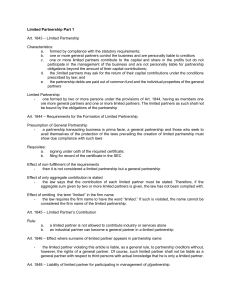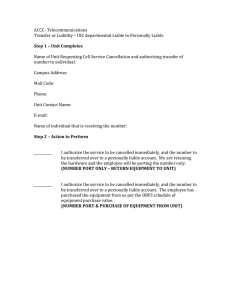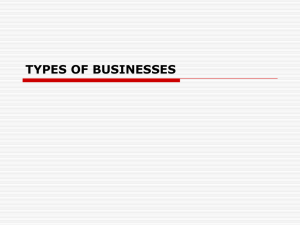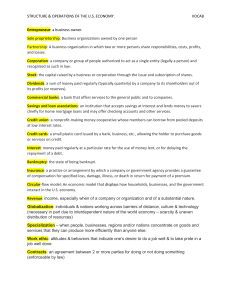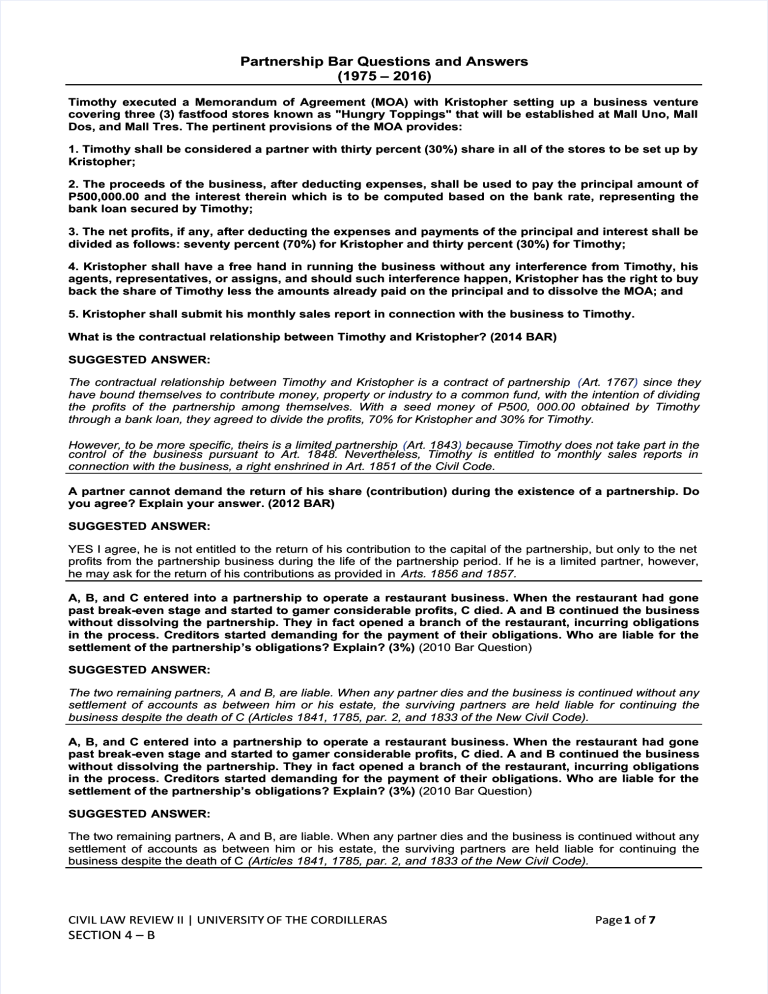
Partnership Bar Questions and Answers (1975 – 2016) Timothy executed a Memorandum of Agreement (MOA) with Kristopher setting up a business venture covering three (3) fastfood stores known as "Hungry Toppings" that will be established at Mall Uno, Mall Dos, and Mall Tres. The pertinent provisions of the MOA provides: 1. Timothy shall be considered a partner with thirty percent (30%) share in all of the stores to be set up by Kristopher; 2. The proceeds of the business, after deducting expenses, shall be used to pay the principal amount of P500,000.00 and the interest therein which is to be computed based on the bank rate, representing the bank loan secured by Timothy; 3. The net profits, if any, after deducting the expenses and payments of the principal and interest shall be divided as follows: seventy percent (70%) for Kristopher and thirty percent (30%) for Timothy; 4. Kristopher shall have a free hand in running the business without any interference from Timothy, his agents, representatives, or assigns, and should such interference happen, Kristopher has the right to buy back the share of Timothy less the amounts already paid on the principal and to dissolve the MOA; and 5. Kristopher shall submit his monthly sales report in connection with the business to Timothy. What is the contractual relationship between Timothy and Kristopher? (2014 BAR) SUGGESTED ANSWER: The contractual relationship between Timothy and Kristopher is a contract of partnership (Art. 1767) since they have bound themselves to contribute money, property or industry to a common fund, with the intention of dividing the profits of the partnership among themselves. With a seed money of P500, 000.00 obtained by Timothy through a bank loan, they agreed to divide the profits, 70% for Kristopher and 30% for Timothy. However, to be more specific, theirs is a limited partnership (Art. 1843 ) because Timothy does not take part in the control of the business pursuant to Art. 1848. Nevertheless, Timothy is entitled to monthly sales reports in connection with the business, a right enshrined in Art. 1851 of the Civil Code. A partner cannot demand the return of his share (contribution) during the existence of a partnership. Do you agree? Explain your answer. (2012 BAR) SUGGESTED ANSWER: YES I agree, he is not entitled to the return of his contribution to the capital of the partnership, but only to the net profits from the partnership business during the life of the partnership period. If he is a limited partner, however, he may ask for the return of his contributions as provided in Arts. 1856 and 1857. A, B, and C entered into a partnership to operate a restaurant business. When the restaurant had gone past break-even stage and started to gamer considerable profits, C died. A and B continued the business without dissolving the partnership. They in fact opened a branch of the restaurant, incurring obligations in the process. Creditors started demanding for the payment of their obligations. Who are liable for the settlement of the partnership’s partnership ’s obligations? Explain? (3%) (2010 Bar Question) SUGGESTED ANSWER: The two remaining partners, A and B, are liable. When any partner dies and the business is continued without any settlement of accounts as between him or his estate, the surviving partners are held liable for continuing the business despite the death of C (Articles 1841, 1785, par. 2, and 1833 of the New Civil Code). A, B, and C entered into a partnership to operate a restaurant business. When the restaurant had gone past break-even stage and started to gamer considerable profits, C died. A and B continued the business without dissolving the partnership. They in fact opened a branch of the restaurant, incurring obligations in the process. Creditors started demanding for the payment of their obligations. Who are liable for the settlement of the partnership’s obligations? Explain? (3%) (2010 Bar Question) SUGGESTED ANSWER: The two remaining partners, A and B, are liable. When any partner dies and the business is continued without any settlement of accounts as between him or his estate, the surviving partners are held liable for continuing the business despite the death of C (Articles 1841, 1785, par. 2, and 1833 of the New Civil Code). CIVIL LAW REVIEW II | UNIVERSITY OF THE CORDILLERAS SECTION 4 – B Page 1 of 7 A, B, and C entered into a partnership to operate a restaurant business. When the restaurant had gone past break-even stage and started to gamer considerable profits, C died. A and B continued the business without dissolving the partnership. They in fact opened a branch of the restaurant, incurring obligations in the process. Creditors started demanding for the payment of their obligations. xxx B. What are the creditors’ recourse/s? Explain. (3%) (2010 Bar Question) SUGGESTED ANSWER: Creditors can file the appropriate actions, for instance, an action for the collection of sum of money against the “partnership at will” and if there are no sufficient funds, the creditors may go after the private properties of Aand B (Article 1816,New Civil Code). Creditors may also sue the estate of C. The estate is not excused from the liabilities of the partnership even if C is dead already but only up to the time that he remained a partner (Article 1829, 1835, par. 2; NCC, Testate Estate of Mota v. Serra, 47 Phil. 464 [1925]). However, the liability of C’s individual property shall be subject first to the payment of his separate debts (Article (Ar ticle 1835,New Civil Code). A, B, and C entered into a partnership to operate a restaurant business. When the restaurant had gone past break-even stage and started to gamer considerable profits, C died. A and B continued the business without dissolving the partnership. They in fact opened a branch of the restaurant, incurring obligations in the process. Creditors started demanding for the payment of their obligations. Who are liable for the settlement of the partnership’s obligations? Explain? (3%) (2010 Bar Question) SUGGESTED ANSWER: The two remaining partners, A and B,him are or liable. diespartners and the are business is continued without any settlement of accounts as between his When estate,any thepartner surviving held liable for continuing the business despite the death of C (Articles 1841, 1785, par. 2, and 1833 of the New Civil Code). What are the creditors’ recourse/s? Explain. (3%) (2010 Bar Question) SUGGESTED ANSWER: Creditors can file the appropriate actions, for instance, an action for the collection of sum of money against the “partnership at will” and if there are no sufficient funds, the creditors may go after the private properties of A and B (Article 1816, New Civil Code). Creditors may also sue the estate of C. The estate is not excused from the liabilities of the partnership even if C is dead already but only up to the time that he remained a partner (Article 1829, 1835, par. 2; NCC, Testate Estate of Mota v. Serra, 47 Phil. 464 [1925]). However, the liability of C’s individual property shall be subject first to the payment of his separate debts (Article (Ar ticle 1835, New Civil Code). TRUE or FALSE. Answer TRUE if the statement is true, or FALSE if the statement is false. Explain your answer in not more than two (2) sentences. (5%) x x x [c] An oral partnership is valid. (2009 Bar Question) SUGGESTED ANSWER: TRUE. Partnership is a consensual contract, hence, it is valid even though not in writing. ANOTHER SUGGESTED ANSWER: TRUE. An oral contract of partnership is valid even though not in writing. However, if it involves contribution of an immovable property or a real right, an oral contract of partnership is void. In such a case, the contract of partnership to be valid, must be in a public instrument (Ar (Art. t. 1771, NCC), and the inventory of said property signed by the parties must be attached to said public instrument (Art. 1773, NCC.). ANOTHER SUGGESTED ANSWER: TRUE. Partnership is a consensual contract, hence, it is valid even though not in writing. The oral contract of partnership is also valid even if an immovable property or real right r ight is contributed cont ributed thereto. While the law in such s uch a case, requires the partnership to be in a public document, the law does not expressly declare the contract void if not executed in the required form (Article 1409[7], NCC). And there being nothing in the law from which it can be inferred that the said requirement is prohibitory or mandatory (Article 5, NCC), the said oral contract of partnership CIVIL LAW REVIEW II | UNIVERSITY OF THE CORDILLERAS SECTION 4 – B Page 2 of 7 must also be valid. The interested party may simply require the contract to be made into a public document in order to comply with the required form (Article 1357, NCC). The purpose of the law in requiring a public document is simply to notify the public about the contribution. Joe and Rudy formed a partnership to operate a car repair shop in Quezon City. Joe provided the capital while Rudy contributed his labor and industry. On one side of their shop, Joe opened and operated a coffee shop, while on the other side, Rudy put up a car accessories store. May they engage in such separate businesses? Why? (5%) (2001 Bar Question) SUGGESTED ANSWER: Joe, the capitalist partner, may engage in the restaurant business because it is not the same kind of business the partnership is engaged in. On the other hand, Rudy may not engage in any other business unless their partnership permits him to do so because as an industrial industria l partner part ner he has tto o devote his ffull ull time to the business of expressly the partnership (Art. 1789, CC). Dielle, Karlo and Una are general partners in a merchandising firm. Having contributed equal amounts to the capital, they also agree on equal distribution of whatever net profit is realized per fiscal period. After two years of operation, however, Una conveys her whole interest in the partnership to Justine, without the knowledge and consent of Dielle and Kaflo. A. Is the partnership dissolved? [2%] B. What are the rights of Justine, if any, should she desire to participate in the management of the partnership and in the distribution of a net profit of P360.000.00 which was realized after her purchase of Una’s interest? [3%] (1998 Bar Question) SUGGESTED ANSWER: A. No, a conveyance by a partner of his whole interest in a partnershi partnership p does not of itself dissolve the partnership partner ship in the absence of an agreement. (Art. 1813, Civil Code) B. Justine cannot interfere or participate in the management or administration of the partnership business or affairs. She may, however, receive the net profits to which Una would have otherwise been entitled. In this case, P120,000 (Art. 1813, Civil Code) Stating briefly the thesis to support your answer to each of the following cases, will the death – xxx (b) of a partner terminate the partnership? (1997 Bar Question) SUGGESTED ANSWER: Yes. The death of a partner will terminate the partnership, by express provision of par. 5, Art. 1830 of the Civil Code. Pauline, Patricia and Priscilla formed a business partnership for the purpose of engaging in neon advertising for a term of five (5) years. Pauline subsequently assigned to Philip her interest in the partnership. When Patricia and Priscilla learned of the assignment, they decided to dissolve the partnership before the expiration of its term as they had an unproductive business relationship with Philip in the past. On the other hand, unaware of the move of Patricia and Priscilla but sensing their negative reaction to to his acquisition of Pauline’s interest, Philip simultaneously petitioned for the dissolution of the partnership. 1. Is the dissolution done by Patricia and Priscilla without the consent of Pauline or Philip valid? Explain. 2. Does Philip have any right to petition for the dissolution of the partnership before the expiration of its specified term? Explain. (1995 Bar Question) SUGGESTED ANSWER: 1. Under Art. 1830 (1) (c) of the NCC, the dissolution by Patricia and Priscilla is valid and did not violate the contract of partnership even though Pauline and Philip did not consent thereto. The consent of Pauline is not necessary because she had already assigned her interest to Philip, The consent of Philip is not also necessary because the assignment to him of Pauline’s Pau line’s interest did not make him a partner, under Art. 1813 of the NCC. CIVIL LAW REVIEW II | UNIVERSITY OF THE CORDILLERAS SECTION 4 – B Page 3 of 7 ALTERNATIVE ANSWER: Interpreting Art. 1830 (1) (c) to mean that if one of the partners had assigned his interest on the partnership to another the remaining partners may not dissolve the partnership, the dissolution by Patricia and Priscilla without the consent of Pauline or Philip is not valid. 2. No, Philip has no right to petition for dissolution because he does not have the standing of a partner (Art. 1813 NCC). 1) Can a husband and wife form a limited partnership to engage in real estate business, with the wife being a limited partner? 2) Can two corporations organize a general partnership under the Civil Code of the Philippines? 3) Can a corporation and an individual form a general partnership? (1994 Bar Question) SUGGESTED ANSWER: 1) a) Yes. The Civil Code prohibits a husband and wife from constituting a universal partnership. Since a limited partnership is not a universal partnership, a husband and wife may validly form one. b) Yes. While spouses cannot enter into a universal partnership, they can enter into a limited partnership or be members thereof (CIR u. Suter, etal. 27 SCRA 152). 2) a) No, A corporation Is managed by its board of directors. If the corporation were to become a partner, copartners would have the power to make the corporation party to transactions in an irregular manner since the partners are not agents subject to the control of the Board of Directors, But a corporation may enter into a joint venture with another corporation as long as the nature of the venture is in line with the business authorized by its charter. (Tuason & Co., Inc. v. Bolano, 95 Phil. 106). b) As a general rule a corporation may not form a general partnership with another corporation or an individual because a corporation may not be bound by persons who are neither directors nor officers of the corporation. However, a corporation may form a general partnership with another corporation or an individual provided the following conditions are met: 1) The Articles of Incorporation of the corporation expressly allows the corporation to enter into partnerships; 2) The Articles of Partnership must provide that all partners will manage the partnership, and they shall be jointly and severally liable; and 3) In case of a foreign corporation, it must be licensed to do business in the Philippines. c) No. A corporation may not be a general partner because the principle of mutual agency in general partnership allowing the other general partner to bind b ind the corporation will violate the corporation law principle that only the board of directors may bind the corporation. 3) No, for the same reasons given in the Answer to Number 2 above. A, B and C formed a partnership for the purpose of contracting with the Government in the construction of one of its bridges. On June 30, 1992, after completion of the project, the bridge was turned over by the partners to the Government. On August 30, 1992, D. a supplier of materials used in the project sued A for collection of the indebtedness to him. A moved to dismiss the complaint against him on the ground that it was the ABC partnership that is liable for the debt. D replied that ABC partnership was dissolved upon completion of the project for which purpose the partnership was formed. Will you dismiss the complaint against B if you were the judge? (1993 Bar Question) SUGGESTED ANSWER: As Judge. I would not n ot dismiss the compla complaint int against A because A is still liable lia ble as a general partner part ner for his pro pr o rata share of 1/3 (Art. 1816, C. C.). Dissolution of a partnership caused by the termination of the particular undertaking specified in the agreement does not extinguish obligations, which must be liquidated during the “winding up" of the partnership affairs (Articles 1829 and 1830, par. 1-a, Civil Code). W, X, Y and Z organized a general partnership with W and X as industrial partners and Y and Z as capitalist partners. Y contributed P50.000.00 and Z contributed P20.000.00 to the common fund. By a unanimous vote of the partners, W and X were appointed managing partners, without any specification of their respective powers and duties. CIVIL LAW REVIEW II | UNIVERSITY OF THE CORDILLERAS SECTION 4 – B Page 4 of 7 A applied for the position of Secretary and B applied for the position of Accountant of the partnership. The hiring of A was decided upon by W and X, but was opposed by Y and Z. The hiring of B was decided upon by W and Z, but was opposed by X and Y. Who of the applicants should be hired by the partnership? Explain and give your reasons. (1992 Bar Question) SUGGESTED ANSWER: A should be hired as Secretary. The decision for the hiring of A prevails because it is an act of administration which can be performed by the duly appointed managing partners, W and X. B cannot be hired, because in case of a tie in the decision of the managing partner, the deadlock must be decided by the partners owning the controlling interest. In this case, the opposition of X and Y prevails because Y owns the controlling interest (Art. 1801, Civil Code). “X” used his savings from his salaries amounting to a little more than P2,000 as capital in establishing a restaurant. “Y” gave the amount of P4,000 to “X” as “financial assistance” with the understanding that “Y” would be entitled to 22% of the annual profits derived from the operation of the restaurant. After the lapse of 22 2 2 years, “Y” filed a case demanding his share in the said profits. “X” denied that there was a partnership and raised the issue of prescription as “Y” did not assert his rights anytime within ten (10) years from the start of the operation of the restaurant . Is “Y” a partner of “X” in the business? Why? What is the nature of the right to demand one’s share in the profits of a partnership? Does this right prescribe? (1989 Bar Question) SUGGESTED ANSWER: Yes, because there is an agreement to contribute to a common fund and an intent to divide profits. It is founded upon an express trust. It is imprescriptible unless repudiated. ALTERNATIVE ANSWER: No, “Y” is not a partner because the amount is extended in the form of a financial assistance arid therefore it i s a loan, and the mere sharing of profits does not establish a partnership. The right is founded upon a contract of loan whereby the borrower is bound to pay principal and interest like all ordinary obligations. Yes, his right prescribes in six or ten years depending upon whether the contract is oral or written. (a) Distinguish co-ownership from partnership. (1988 Bar Question) SUGGESTED ANSWER: Co-ownership is distinguished from an ordinary partnership in the following ways: 1. As to creation: Whereas co-ownership may be created by law, contract, succession, fortuitous event, or occupancy, partnership is always created by contract. 2. As to purpose: Whereas the purpose of co-ownership is the common enjoyment of the thing or right owned in common, the purpose of a partnership is to obtain profits. 3. As to personality: Whereas a co-ownership has no juridical personality which is separate and distinct from that of the owners, a partnership has. 4. As to duration: Whereas an agreement not to divide the community property for more than ten years is not allowed by law such an agreement would be perfectly valid in the case of partnerships. This is so, because under the law, there is no limitation upon the duration of partnerships. 5. As to power of members: Whereas a co-owner has no power to represent the co-ownership unless there is an agreement to that effect, a partner has the power to represent the partnership, unless there is a stipulation to the contrary. 6. As to effect of disposition of shares: If a co-owner transfers his share to a third person, the latter becomes automatically a co -owner, but if a partner transfers his share to a third person, the latter does not become a partner, unless agreed upon by all of the th e partners. 7. As to division of profits: Whereas in co-ownership the division of the benefits and charges is fixed by law, in a partnership the division of profits arid losses may be subject to the agreement of the partners. 8. As to effect of death: Whereas the death of a co-owner has no effect upon the existence of the co-ownership, the death of a partner shall result in. the dissolution of the partnership. CIVIL LAW REVIEW II | UNIVERSITY OF THE CORDILLERAS SECTION 4 – B Page 5 of 7 NOTE: It is recommended that a mention of three distinctions should merit a full credit for this question. Tomas, Rene and Jose entered into a partnership under the firm name “Manila Lumber.” Subsequently, upon mutual agreement, Tomas withdrew from the partnership and the partnership was dissolved. However, the remaining partners, Rene and Jose, did not terminate the business of “Manila Lumber.” Instead of winding up the business of the partnership and liquidating its assets, Rene and Jose continued the business in the name of “Manila Lumber” apparently without objection from Tomas. The withdrawal of Tomas from the partnership was not published in the newspapers. Could Tomas be held liable for any obligation or indebtedness Rene and Jose might incur while doing business in the name of “Manila Lumber” after his withdrawal from the partnership? Explain. (1987 Bar Question) SUGGESTED ANSWER: Yes. Tomas can be held liable under the doctrine of estoppel. But as regards the parties among themselves, only Rene and Jose are liable. Tomas cannot be held liable since there was no proper notification or publication. In the event that Tomas is made to pay the liability to third person, he has the right to seek reimbursement from Rene and Jose (Articles 1837 to 1840; Goquiolay vs. Sycip, 9 SCRA 663). A, B, and C formed a partnership under the following terms and conditions: (a) Participation: A – 40%; B – 40%; C – 20%. (b) A and B would supply the entire capital. C would contribute his management expertise and be manager for the first five years without compensation. (c) C shall not be liable for losses. The partnership became bankrupt. 1. Could A alone, opposed by B and C, have C removed removed as manager? Explain. 2. Could C be personally held liable for debts of the partnership not satisfied with the assets of the partnership. Amplify. (1981 Bar Question) SUGGESTED ANSWER: (1) A, alone, opposed by B and C, cannt have C removed as manager of the partnership. According to the Civil Code, the vote of the partners representing the controlling interest shall be necessary for such revocation of power. Under the partnership agreement, it is crystal clear that the vote of A does not represent the controlling interest. (2) Yes, C can be held personally, although jointly, liable for debts of the partnership not satisfied by the assets of the partnership. Under our partnership law, as among themselves, the industrial partner is always excluded from any participation in the losses in the absence of an agreement to the contrary. Hence, the agreement that C, the industrial partner, shall not not be liable for losses is valid. It merely affirms the law. The rule that a stipulati on which excludes on or more partners in the profits or losses is void, is applicable only to capitalist partners, not to industrial partners. However, as far as third persons are concerned, the rule is different. different. An industrial partner can can be held personally liable. Of course, this is without prejudice to his right to hold his co-partners proportionately liable for what he paid to the partnership creditors. Thus, in the instant case, the liability of "A"', "B" and "C" is joint (pro rata} and subsidiary. The facts merely state that their participation is: "A — 40%; "B" — 40%; "C" -20%. Therefore, since by agreement "C" is excluded from any participation in the losses, the agreement that "C's" participation is 20% applies only to his participation in the profits. In the case of "A" and "B", the agreement applies to both profits and losses. Despite the exclusion of "C" in the losses, such agreement is not applicable insofar as partnership creditors are concerned. Consequently, the liability of the three partners for partnership debts shall also be: 40% for "A", 40% for "B"; and 20% for "C". Hence, "C" can now be compelled to pay 20% of the partnership debts. After payment, he can then proceed against his co-partners "A" and "B" for reimbursement of the amount paid by him. Multiple Choice Questions In 2005, L, M, N, 0 and P formed a partnership. L, M and N were capitalist partners who contributed P500,000 each, while 0, a limited partner, contributed P1 ,000,000. P joined as an industrial partner, contributing only his services. The Articles of Partnership, registered with the Securities and Exchange Commission, designated L and 0 as managing partners; L was liable only to the extent of his capital contribution; and P was not liable for losses. CIVIL LAW REVIEW II | UNIVERSITY OF THE CORDILLERAS SECTION 4 – B Page 6 of 7 In 2006, the partnership earned a net profit of P800,000. In the same year, P engaged in a different business with the consent of all the partners. However, in 2007, the partnership incurred a net loss of P500,000. In 2008,the partners dissolved the partnership. The proceeds of the sale of partnership assets were insufficient to settle its obligation. After liquidation, the partnership had an unpaid liability of P300,000. 1) Assuming that the just and equitable share of the industrial partner, P, in the profit in 2006 amounted to P1 00,000, how much is the share of 0, a limited partner, in the P800,000 net profit? (1%) (2012 Bar Question) (A) P160,000. (B) P175,000. (C) P280,000. (D) P200,000. (E) None of the above. ANSWER: C – P280,000. Since after deducting the P100k share of P there remains P700k, the three partners L, M, N will each have 1 share and O will have two shares (2:1) three shares plus two shares, the balance of P700k will be divided by 5 which will yield the result of P140k multiplied by 2 (for O) 2) In 2007, how much is the share of 0, a limited partner, in the net loss of P500,000? (1%) (2012 BAR) (A) P 0. (B) P1 00,000. (C) P125,000. (D) P200,000. (E) None of the above. ANSWER: D - A rticle 1797 1797 sha s hare re in profits and loss es i s proportionate proportionate to contribution contribution 3) Can the partnership creditors hold L, 0 and Pliable after all the assets of the partnership are exhausted? (1%) (2012 BAR) (A) Yes. The stipulation exempting P from losses is valid only among the partners. L is liable because the agreement limiting his liability to his capital contribution is not valid insofar as the creditors are concerned. Having taken part in the management of the partnership, 0 is liable as capitalist partner. (B) No. P is not liable because there is a valid stipulation exempting him from losses. Since the other partners allowed him to engage in an outside business activity, the stipulation absolving P from liability is valid. For 0, it is basic that a limited partner is liable only up to the extent of his capital contribution. (C) Yes. The stipulations exempting P and L from losses are not binding upon the creditors. 0 is likewise liable because the partnership was not formed in accordance with the requirements of a limited partnership. (D) No. The Civil Code allows the partners to stipulate that a partner shall not be liable for losses. The registration of the Articles of Partnership embodying such stipulations serves as constructive notice to the partnership creditors. (E) None of the above is completely accurate. ANSWER: A – A rticle 17 1799 99 a s tipulat tipulation ion which excludes one or more partners partners from any any s hare in profits and loss es i s void. P, industrial partner may be exempt but that is only with respect to the partners but not the creditors. O, by taking part in the management even if he is a limited partner becomes liable as a general partner (A rticle rti cle 1848) The liability of the partners, including industrial partners for partnership contracts entered into in its name and for its account, when all partnership assets have been exhausted is (2011 BAR) (A) Pro-rata. (B) Joint. (C) Solidary. (D) Voluntary. CIVIL LAW REVIEW II | UNIVERSITY OF THE CORDILLERAS SECTION 4 – B Page 7 of 7

